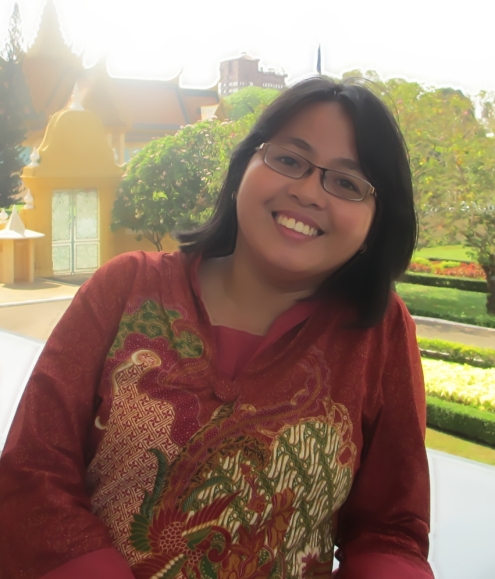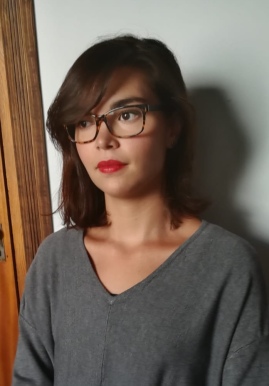
Brief-bio Flora Debora Floris is a lecturer at Petra Christian University, Surabaya, Indonesia where she teaches general/business English and language teaching methodology courses. She has published and given talks on the integration of technology in English language teaching, teachers’ professional development and the teaching of English as an International language. Her recent published papers include Unlocking the potential of SAMR with Willy A. Renandya (English Teaching Professional, 2019), A conversation about supporting teacher research with Willy A. Renandya (ETAS Journal, 2018), and Mining Online L2 Learning Resources: From SLA Principles to Innovative Task Design with Willy A. Renandya and Bao Dat (Multilingual Matters, 2018).
Interview by Ju Seong Lee
1.Thank you for joining us on NNEST-of-the-month blog. Could you briefly tell us about your personal and professional background?
First of all, I would like to say thank you for giving me this valuable opportunity. It is a great honor to share my experiences with the readers of the NNEST of the Month Blog, one of my favorite columns to read.
In terms of academic background, I got my bachelor’s degree in English education from Widya Mandala Catholic University in Surabaya, Indonesia and my master’s degree (MA in ELT) from Assumption University in Bangkok, Thailand. The master program I enrolled in shaped my awareness of critical issues in ELT especially on the issues of teaching EIL. The director of the program Prof. Alan Maley and my lecturers came from different countries and spoke different first languages. Despite their background differences, all of them had graduated from reputable universities and had a lot of professional experience in ELT in various parts of the world. Their deep knowledge and hands-on experiences in teaching, doing research and publication have obviously influenced their classroom practices and inspired their MA students.
Professionally speaking, I have been working at the English Department of Petra Christian University in Surabaya, Indonesia since 2000. I teach a wide range of courses mostly on general English, business English, and language teaching methodology courses.
I also serve as a reviewer and editorial board member for some local and international journals including TEFLIN Journal, RELC Journal, and TESL-EJ. I also assist Dr. Willy A. Renandya, a senior language teacher educator of the National Institute of Education, Nanyang Technological University, Singapore to maintain Teacher Voices (http://www.facebook.com/groups/teachervoices/) which is an online Facebook forum for language teachers, textbook writers, curriculum specialists, and researchers in English language teaching or applied linguistics. The forum was established in 2011 and it now has more than 10,000 members from 40 countries.
2. One of your teaching/research interests includes pedagogical implications of English as an international language (EIL). How did you become interested in this topic?
I became interested in the issues of teaching EIL during my MA study when I took a World Englishes course under the guidance of Dr. Mario Saraceni (currently Reader in English Language and Linguistics in the School of Languages and Area Studiesat the University of Portsmouth, UK). The course really opened my eyes and mind to the world that lies outside of American and British English. The issues of Englishes, Braj Kachru’s circles, native and non-native teachers, English as a medium of instruction, and many others were things that I never thought about at that time. The World Englishes course was a revelation; and I grew my interest on the teaching of English as an international language from this course. On the second year of my MA study, I started my publication journey. My first published article was on the issue of using English as a medium of instruction at Indonesian universities (see Floris, 2002).
3. Can you share a couple of activities of how ELT practitioners can integrate EIL-informed pedagogy into the classroom?
I would recommend readers to refer to the following sources as they present some suggested activities for teaching EIL.
- Floris, F.D. (2014). Introducing English as an International Language (EIL) to Pre-Service Teachers in a World English Course. PASAA Journal, 47 (January – June 2014), 215 – 231.
- Matsuda, A. (2017) Preparing Teachers to Teach English as an International Language. Bristol: Multilingual Matters.
Another good reference isTEFL Equity Advocates website which presented lesson plans aiming at raising students’ awareness of the issues of native speakerism and other EIL issues (http://teflequityadvocates.com/activities-and-lesson-plans/).
4 . Why is it important to introduce EIL-related topics to pre- and in-service teachers in Indonesia?
Well, for me there are at least three major reasons. First, English is used more as L2 than as a mother tongue, and, consequently, the notion that English is exclusively owned by the native-speaking communities is no longer valid as the non-native speakers now also have a right to be heard in matters affecting the language (Widdowson, 1994).
Second, English is now the most widely taught as a second and foreign language in the world (Crystal, 2003). More and more people learn the language from teachers of English to be able to communicate in English. In this global era, I believe that the goal of teaching English should be as what Matsuda said, i.e. to prepare students as competent users of English as an International Language (EIL) (Matsuda, 2018).
Third, the majority (up to 80%) of English language teachers are non-native speakers of the language (Canagarajah, 1999); and the majority of trained ESL/EFL teachers are Non-Native English Speaker Teachers (NNESTs) (Graddol, 2006). Sadly speaking, however, some studies conducted by Reves & Medgyes (1994), Samimy & Brutt-Griffler (1999), Inbar-Lourie’s (2001), and Llurda & Huguet (2003) (as cited in Braine, 2005) show that many NNESTs still consider their NEST colleagues as better language teachers despite of their academic and professional qualifications. A small study towards 11 pre-service teachers taking my course also showed similar findings. At the beginning of the course all pre-service teachers believed that NESTs would serve as the best language teachers because English is the language of native speakers and it is used as their daily communication tool (Floris, 2013). To date, I still find such belief among my student-teachers and our graduates. I find it frustrating when I realize that even our very good student-teachers and graduates still see themselves as imperfect users of English who need to be taught proper English by native speakers.
I was very fortunate that the Head of the English Department and my colleagues strongly supported the idea of having a course Teaching English as an International Language for our student-teachers. The course aims to increase pre-service teachers’ awareness and favorable attitude towards EIL and the teaching of EIL. I also try to introduce the EIL concept in some other subjects such as in Current Issues in Language Educationin which our student-teachers are asked to critically examine various teaching approaches.
5.What are some pedagogical challenges when designing and implementing EIL-related activities? How can teachers overcome these challenges?
It is very challenging to introduce the concept of EIL to people who feel that native speakers are the best models, the best variety is American or British English, or best teaching approach is the one developed and taught by the ‘white’.
Thanks to the technology, nowadays we have unlimited online resources that we can use in introducing EIL and designing EIL-related activities. The International Dialects of English Archive (http://web.ku.edu/~idea/), for example, presents more than 1,000 English recordings made by people (natives) living in 100 different countries. This is a very good website to introduce our students or teacher trainees to various Englishes in the world. Another good website is The TEFLology Podcast (http://teflology.libsyn.com/) which presents discussions on current issues in ELT. Featured speakers come from various countries and teach in many different parts of the world showing that nativeness should not be a major issue in language teaching. I also need to mention Matsuda’s 2017 book and TEFL Equity Advocates website as sources to get ideas on how to bring EIL topics to language classrooms. I believe there would be more practical sources or references available in the future.
6. Could you tell us about your current and future teaching/research plans?
I am preparing two book chapters on teacher professional development, two articles on EIL, and one edited book on inspirational stories from English classrooms. I hope to get them all published in 2019. I have just started doing my doctorate in a state university in Indonesia, and I am planning to conduct my research on the issue of teacher research. It is quite challenging to manage my time as I also have classes to teach and children to take care of. I am trying my best though.
References
Braine, G. (2005). A history of research on non-native speaker English teachers. In E. Llurda (Ed.), Non-native language teachers: Perceptions, challenges and contributions to the profession(pp. 13-23). New York: Springer.
Canagarajah, A. S. (1999). Interrogating the “native speaker fallacy”: Non-linguistic roots, non-pedagogical results. In G. Braine (Ed.),Non-native educators in English language teaching(pp. 77-92). Mahwah: Lawrence Erlbaum Associates.
Crystal, D. (2003). English as a global language (2nd ed.).Cambridge: Cambridge University Press.
Graddol, D. (2006). English next. Retrieved March 1, 20-9, from http://www.britishcouncil.de/pdf/english‐next‐2006.pdf
Floris, F.D. (2002). Immersion program at Indonesian universities: Good or evil?. English Edu, 1 (2), 367-378.
Floris, F.D. (2013). Exploring Beliefs of Pre-Service Teachers toward English as an International Language. ThaiTESOL Journal, 26 (1), 46-75.
Floris, F.D. (2014). Introducing English as an International Language (EIL) to Pre-Service Teachers in a World English Course. PASAA Journal, 47 (January – June 2014), 215 – 231.
Matsuda, A. (2017) Preparing Teachers to Teach English as an International Language. Bristol: Multilingual Matters.
Matsuda, A. (2018). Is Teaching English as an International Language All about Being Politically Correct? RELC Journal, 49(1), 24–35.
Widdowson, H.G. (1994) The ownership of English. TESOL Quarterly28 (2), 377–381.



